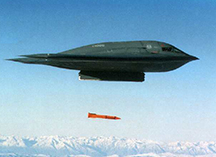A new Integrated Stockpile Evaluation (ISE) program rolling out in May involves multiple cross-disciplinary Sandia teams working together to better ensure the safety, security, and reliability of the country’s nuclear weapons stockpile. The approach will integrate several different weapons evaluation activities into one lean, more cost-effective evaluation program.

“We have many individuals and teams working very hard to design and develop the future evaluation program,” says Dave Corbett, director of Stockpile Resource Center 2900 and chair of the ISE Director Steering Committee. “Teams are working on individual elements of the program — all striving to examine every aspect of current ways of evaluating the stockpile and then redesigning the program to meet the needs for future stockpile evaluation.”
The teams consist of representatives from across the nuclear weapons program, including systems, components, surveillance, assessment, and engineering science organizations.
Every year the three nuclear weapons laboratories assess the state of the stockpile, and the laboratory directors report their conclusions from this assessment to the Secretary of Energy. ISE will help strengthen confidence in this assessment.
The new program is an important Nuclear Weapon Strategic Management Unit (NWSMU) transformation initiative, one that Steve Rottler, VP of Weapon Engineering and Product Realization, calls essential.
“The transformation of stockpile evaluation is imperative, as is the transformation of the stockpile itself,” Steve says. “The current approach used for stockpile evaluation is no longer sustainable technically or financially.”
He adds, “Many studies and assessments have recommended improvements in our stockpile evaluation approach. One example is the 150-Day Study, which was published in January 2001. Through the Integrated Stockpile Evaluation effort, we have revalidated and updated the drivers for change in this area, and now it is time to act — with the goal of achieving a rapid transformation of the way that we evaluate the stockpile.”
The transformation of stockpile evaluation will address the current stockpile and the Life Extension Programs and be extendable to accommodate future stockpile characteristics.
Evaluation to evolve over life cycle
In the past, the core part of stockpile evaluation was pulling 11 random weapons from each of the nine enduring stockpile systems and testing them both at Sandia’s Weapons Evaluation Test Laboratory (WETL) at the Pantex Plant near Amarillo and in the flight test program performed jointly with the Department of Defense. The purpose of this testing was often described as “detecting defects.”
The transformed approach to stockpile evaluation recognizes the need for evaluation to evolve over the weapon system life cycle. Early on, the focus is on detecting unanticipated design or production defects. However, once enough data is accumulated to provide reasonable confidence that any remaining defects are very small in number, the focus of the program can be shifted to look for trends, aging, and degradation.
Most weapons in the current stockpile range from between 15 to 40 years old and are ready for a more focused evaluation program to fill knowledge gaps, quantify margins, and monitor for aging.
Sheryl Hingorani, manager of Integrated Stockpile Evaluation Dept. 2901 and head of the ISE implementation program, says that revising Sandia’s sampling rationale is the most significant initial change.
High confidence in previous results
“We have high confidence that we have found most of the prominent defects in the existing weapons systems through the previous years of testing,” Sheryl says. “The new approach will be driven by a strong technical requirements basis, where the data needs drive the sample requirements. We call this a ‘bottoms-up approach.’ And, we will be developing science-based tools, such as modern computational models and simulation, and new diagnostics for fundamental characterization of aging to gain a predictive understanding of the state of health of the stockpile.”
Sheryl anticipates that ISE will allow Sandia to gain more knowledge from each stockpile sample, allowing a decrease in the overall quantity of field return samples required. It will also improve cost effectiveness. This should be a result of integrated policies and processes, unambiguous roles and responsibilities, strong technical requirements for the evaluation programs, improved data analysis and information systems, efficient communications, and targeted research and development efforts.
There’s one other plus of ISE, says Dave. Staff working in Sandia’s nuclear weapons program will be challenged by many aspects of the new ISE program.
“It will create new technically challenging opportunities for our staff, particularly in areas of component evaluation and in developing new tools and capabilities for monitoring performance trends and the effects of aging,” Dave says. “We are already creating new and expanded capabilities, including the addition of new test equipment at WETL. “
He adds, “The transformation of stockpile evaluation extends beyond Sandia and involves partnerships with our sister labs and the plants. We will continue to be challenged over the next several years to fully transform the program with support needed from across the complex. Expanded efforts to change current processes, requirements, and supporting infrastructure will be needed to achieve transformation.”